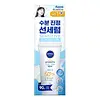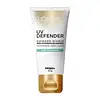Nivea Sensitive Sun Serum Protect & Light Feel SPF 50+ Versus L'Oreal UV Defender Anti-Shine Clear SPF 50+
What's inside
What's inside
 Key Ingredients
Key Ingredients

 Benefits
Benefits

 Concerns
Concerns

 Ingredients Side-by-side
Ingredients Side-by-side

Water
Skin ConditioningHomosalate
Skin ConditioningButyl Methoxydibenzoylmethane
UV AbsorberEthylhexyl Salicylate
UV AbsorberOctocrylene
UV AbsorberAlcohol Denat.
AntimicrobialDimethicone
EmollientTapioca Starch
Phenylbenzimidazole Sulfonic Acid
UV AbsorberGlycerin
HumectantBehenyl Alcohol
EmollientCetearyl Alcohol
EmollientMethylpropanediol
SolventSilica Dimethyl Silylate
EmollientGlycyrrhiza Glabra Root Extract
BleachingCarnitine
CleansingTocopheryl Acetate
AntioxidantIsoamyl Laurate
EmollientXanthan Gum
EmulsifyingAcrylates/C10-30 Alkyl Acrylate Crosspolymer
Emulsion StabilisingCarbomer
Emulsion StabilisingDimethicone Crosspolymer
Emulsion StabilisingSodium Stearoyl Glutamate
CleansingSilica
AbrasiveEthylhexylglycerin
Skin ConditioningTrisodium EDTA
Sodium Chloride
MaskingSodium Hydroxide
BufferingPhenoxyethanol
PreservativeCI 77891
Cosmetic ColorantWater, Homosalate, Butyl Methoxydibenzoylmethane, Ethylhexyl Salicylate, Octocrylene, Alcohol Denat., Dimethicone, Tapioca Starch, Phenylbenzimidazole Sulfonic Acid, Glycerin, Behenyl Alcohol, Cetearyl Alcohol, Methylpropanediol, Silica Dimethyl Silylate, Glycyrrhiza Glabra Root Extract, Carnitine, Tocopheryl Acetate, Isoamyl Laurate, Xanthan Gum, Acrylates/C10-30 Alkyl Acrylate Crosspolymer, Carbomer, Dimethicone Crosspolymer, Sodium Stearoyl Glutamate, Silica, Ethylhexylglycerin, Trisodium EDTA, Sodium Chloride, Sodium Hydroxide, Phenoxyethanol, CI 77891
Water
Skin ConditioningHomosalate
Skin ConditioningSilica
AbrasiveIsononyl Isononanoate
EmollientEthylhexyl Triazone
UV AbsorberButyl Methoxydibenzoylmethane
UV AbsorberBis-Ethylhexyloxyphenol Methoxyphenyl Triazine
Skin ConditioningDiisopropyl Sebacate
EmollientGlycerin
HumectantAluminum Starch Octenylsuccinate
AbsorbentPhenylbenzimidazole Sulfonic Acid
UV AbsorberOctocrylene
UV AbsorberCaprylyl Methicone
Skin ConditioningPentylene Glycol
Skin ConditioningTriethanolamine
BufferingTitanium Dioxide
Cosmetic ColorantPotassium Cetyl Phosphate
EmulsifyingMethylene Bis-Benzotriazolyl Tetramethylbutylphenol
UV FilterPhenoxyethanol
PreservativeStearic Acid
CleansingPalmitic Acid
EmollientPEG-100 Stearate
Glyceryl Stearate
EmollientAmmonium Acryloyldimethyltaurate/Vp Copolymer
Parfum
MaskingSodium Methyl Stearoyl Taurate
CleansingCaprylyl Glycol
EmollientStearyl Alcohol
EmollientTerephthalylidene Dicamphor Sulfonic Acid
UV AbsorberTocopherol
AntioxidantChlorphenesin
AntimicrobialPoloxamer 338
EmulsifyingPolyglyceryl-10 Laurate
Skin ConditioningAcrylates/C10-30 Alkyl Acrylate Crosspolymer
Emulsion StabilisingCellulose
AbsorbentButylene Glycol
HumectantAluminum Hydroxide
EmollientSilica Silylate
EmollientMenthoxypropanediol
MaskingDisodium EDTA
Myristic Acid
CleansingSodium Hyaluronate
HumectantT-Butyl Alcohol
PerfumingWater, Homosalate, Silica, Isononyl Isononanoate, Ethylhexyl Triazone, Butyl Methoxydibenzoylmethane, Bis-Ethylhexyloxyphenol Methoxyphenyl Triazine, Diisopropyl Sebacate, Glycerin, Aluminum Starch Octenylsuccinate, Phenylbenzimidazole Sulfonic Acid, Octocrylene, Caprylyl Methicone, Pentylene Glycol, Triethanolamine, Titanium Dioxide, Potassium Cetyl Phosphate, Methylene Bis-Benzotriazolyl Tetramethylbutylphenol, Phenoxyethanol, Stearic Acid, Palmitic Acid, PEG-100 Stearate, Glyceryl Stearate, Ammonium Acryloyldimethyltaurate/Vp Copolymer, Parfum, Sodium Methyl Stearoyl Taurate, Caprylyl Glycol, Stearyl Alcohol, Terephthalylidene Dicamphor Sulfonic Acid, Tocopherol, Chlorphenesin, Poloxamer 338, Polyglyceryl-10 Laurate, Acrylates/C10-30 Alkyl Acrylate Crosspolymer, Cellulose, Butylene Glycol, Aluminum Hydroxide, Silica Silylate, Menthoxypropanediol, Disodium EDTA, Myristic Acid, Sodium Hyaluronate, T-Butyl Alcohol
Ingredients Explained
These ingredients are found in both products.
Ingredients higher up in an ingredient list are typically present in a larger amount.
Acrylates/C10-30 Alkyl Acrylate Crosspolymer is a synthetic polymer. It is used to thicken and improve the texture of products. Due to its properties, it can prevent water and oil ingredients from separating.
Also known as Avobenzone, this ingredient is a chemical sunscreen filter that provides protection in the UV-A range.
Avobenzone is globally approved and is the most commonly used UV-A filter in the world.
Studies have found that avobenzone becomes ineffective when exposed to UV light (it is not photostable; meaning that it breaks down in sunlight). Because of this, formulations that include avobenzone will usually contain stabilizers such as octocrylene.
However, some modern formulations (looking at you, EU!) are able to stabilize avobenzone by coating the molecules.
Avobenzone does not protect against the UV-B range, so it's important to check that the sunscreen you're using contains other UV filters that do!
The highest concentration of avobenzone permitted is 3% in the US, and 5% in the EU.
Learn more about Butyl MethoxydibenzoylmethaneGlycerin is already naturally found in your skin. It helps moisturize and protect your skin.
A study from 2016 found glycerin to be more effective as a humectant than AHAs and hyaluronic acid.
As a humectant, it helps the skin stay hydrated by pulling moisture to your skin. The low molecular weight of glycerin allows it to pull moisture into the deeper layers of your skin.
Hydrated skin improves your skin barrier; Your skin barrier helps protect against irritants and bacteria.
Glycerin has also been found to have antimicrobial and antiviral properties. Due to these properties, glycerin is often used in wound and burn treatments.
In cosmetics, glycerin is usually derived from plants such as soybean or palm. However, it can also be sourced from animals, such as tallow or animal fat.
This ingredient is organic, colorless, odorless, and non-toxic.
Glycerin is the name for this ingredient in American English. British English uses Glycerol/Glycerine.
Learn more about GlycerinHomosalate is a chemical sunscreen filter that provides protection in the UV-B range (280nm - 320 nm), with a peak protection at 306 nm. It is internationally approved for use in sunscreens.
Homosalate is not photo-stable, meaning it's strength as a UV filter degrades over time with exposure to the sun. Because of this, it's often used in combination with other chemical sunscreen filters as avobenzone (which protects from the UV-A range). Homosalate also helps act as a solvent for harder-to-dissolve UV filters.
(Part of the reason that sunscreens need to be frequently re-applied is due to the photo instability of many chemical sunscreen filters)
Currently, homosalate is approved in concentrations up to 10% in the EU and 15% in the US. The FDA is currently doing further research on the effects of homosalate, and it is possible that these approved concentrations will change in the future.
Learn more about HomosalateOctocrylene protects skin from sun damage. It absorbs UV-B with peak absorption of 304 nm. It is a common sunscreen ingredient and often paired with avobenzone, a UVA filter. This is because octocrylene stabilizes other sunscreen ingredients by protecting them from degradation when exposed to sunlight. Octocrylene is a photostable ingredient and loses about 10% of SPF in 95 minutes.
Octocrylene also acts as an emollient, meaning it helps skin retain moisture and softens skin. It is oil-soluble and hydrophobic, enhancing water-resistant properties in a product.
Those who are using ketoprofen, a topical anti-inflammatory drug, may experience an allergic reaction when using octocrylene. It is best to speak with a healthcare professional about using sunscreens with octocrylene.
The EU allows a maximum of these concentrations:
Learn more about OctocrylenePhenoxyethanol is a preservative that has germicide, antimicrobial, and aromatic properties. Studies show that phenoxyethanol can prevent microbial growth. By itself, it has a scent that is similar to that of a rose.
It's often used in formulations along with Caprylyl Glycol to preserve the shelf life of products.
This ingredient is more commonly known as Ensulizole, a chemical sunscreen ingredient.
Ensulizole mainly protects UV-B (290-340 nm) but offers a little UV-A (320-400 nm) protection. It is often paired with less photo-stable sunscreen ingredients due to its photo-stability.
Due to it being water-soluble, Ensulizole helps give sunscreens a light and non-oily texture.
Ensulizole is approved worldwide:
Learn more about Phenylbenzimidazole Sulfonic AcidSilica, also known as silicon dioxide, is a naturally occurring mineral. It is used as a fine, spherical, and porous powder in cosmetics.
Though it has exfoliant properties, the function of silica varies depending on the product.
The unique structure of silica enhances the spreadability and adds smoothness, making it a great texture enhancer.
It is also used as an active carrier, emulsifier, and mattifier due to its ability to absorb excess oil.
In some products, tiny microneedles called spicules are made from silica or hydrolyzed sponge. When you rub them in, they lightly polish away dead skin layers and enhance the penetration of active ingredients.
Learn more about SilicaWater. It's the most common cosmetic ingredient of all. You'll usually see it at the top of ingredient lists, meaning that it makes up the largest part of the product.
So why is it so popular? Water most often acts as a solvent - this means that it helps dissolve other ingredients into the formulation.
You'll also recognize water as that liquid we all need to stay alive. If you see this, drink a glass of water. Stay hydrated!
Learn more about Water